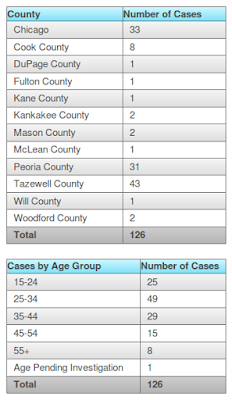 |
| Screen shot from IDPH Webinar |
#13,268
Although the number of new cases appears to be slowing, more than a month into this cluster of severe bleeding caused by the use of rodenticide-laced drugs, the numbers continue to climb.
At least five states (Illinois, Indiana, Maryland, Missouri & Wisconsin) have reported cases, but Illinois has - by far - seen the vast majority, including 3 deaths.The Friday afternoon update from the IDPH reads:
Synthetic Cannabinoids
As of April 13, 2018, IDPH has received reports of 126 cases, including three deaths, linked to an outbreak, since March 7, 2018; cases report using synthetic cannabinoid products before suffering from severe bleeding.
***Numbers are provisional and subject to change; IDPH will update the website everyday at 1:30pm, for the duration of the outbreak***
Additionally the IDPH has released a brief (narrated slide-show) webinar for clinicians, which can be viewed online at:
While these recent adverse outcomes have raised new concerns over the use of synthetic cannabinoids (Spice/K2/ `Fake Weed'), they already had a pretty nasty reputation among mental health professionals and ER staff.
A few past blogs include:
- In 2013 we looked at an MMWR report of these Synthetic Cannabinoids Associated With Severe Illness, Stroke & Psychosis, and a study from USF linking their use to ischemic stroke.
- A year later we saw the Governor of New Hampshire declare a 21-day state of Emergency after 40 `serious overdoses' were reported in his state over just 72 hours (see NH Governor Declares State Of Emergency Over `Spice’ Overdoses).
- And again in the summer of 2015, in MMWR: Adverse Health Effects Related to Synthetic Cannabinoid Use, we looked at a Notes from the Field that looked at a recent surge in monthly calls to poison centers related to cannabinoid ingestion.
CDC - Synthetic cannabinoids: What are they? What are their effects?
NIH - Synthetic Cannabinoids (K2/Spice)

